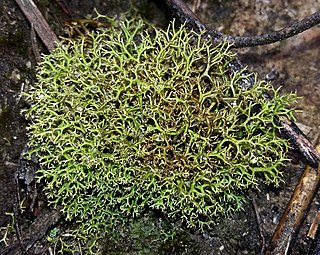
The Arthoniales is the second largest order of mainly crustose lichens, but fruticose lichens are present as well. The order contains around 1500 species, while the largest order with lichenized fungi, the Lecanorales, contains more than 14000 species.

The Roccellaceae are a family of fungi in the order Arthoniomycetes. Most taxa are lichenized with green algae, although some are lichenicolous, growing on other lichens.

Ochrolechia is a genus of crustose lichens in the family Ochrolechiaceae.

Cladia is a genus of lichen-forming fungi in the family Cladoniaceae. Cladia species have a crustose or squamulose (scaly) primary thallus and a fruticose, secondary thallus, often referred to as pseudopodetium. The type species of the genus, Cladia aggregata, is widely distributed, occurring in South America, South Africa, Australasia and South-East Asia to southern Japan and India. Most of the other species are found in the Southern Hemisphere.
Septotrapelia is a genus of lichen-forming fungi in the family Pilocarpaceae. It has four species. It was validly published as a genus in 2007 by lichenologists André Aptroot and Jose-Luis Chaves.

Gassicurtia is a genus of lichenized fungi in the family Caliciaceae.

Enterographa is a genus of lichens in the family Roccellaceae.

Lecanographa is a genus of about 40 species of lichens in the family Lecanographaceae. It was circumscribed in 1994 by José M. Egea and Pilar Torrente, with Lecanographa lyncea as the type species.
Sclerophyton is a genus of lichen-forming fungi in the family Opegraphaceae. It has about 15 species. The genus was circumscribed by German lichenologist Franz Gerhard Eschweiler in 1824, with Sclerophyton elegans assigned as the type species.

Lecidella is a genus of crustose lichens in the family Lecanoraceae.

Hypocenomyce is a genus of lichen-forming fungi in the family Ophioparmaceae. Species in the genus grow on bark and on wood, especially on burned tree stumps and trunks in coniferous forest. Hypocenomyce lichens are widely distributed in the northern hemisphere.

Schaereria is a genus of lichen-forming fungi. It is the sole genus in the family Schaereriaceae, which itself is the only family in the Schaereriales, an order in the subclass Ostropomycetidae of the class Lecanoromycetes. Most Schaereria species are crustose lichens that live on rocks. Schaereria was first proposed by Gustav Wilhelm Körber in 1855 and was later taken up by other lichenologists despite periods of disuse.

Herpothallon is a genus of crustose lichens in the family Arthoniaceae. It has about 50 species.
Angiactis is a genus of crustose lichens of uncertain familial placement in the order Arthoniales. It has four species.

Crocodia is a genus of foliose lichens in the family Peltigeraceae. It has eight species. The genus has a cosmopolitan distribution, although most species occur in temperate and tropical regions of the Southern Hemisphere. The main characteristics of the genus that separate it from its parent genus, Pseudocyphellaria, include a yellow medulla and yellow pseudocyphellae on the lower thallus surface.
Vigneronia spieri is a species of corticolous (bark-dwelling), crustose lichen in the family Roccellaceae. It is found in the Galápagos Islands, mainland Ecuador and the Antilles (Curaçao).

Fulvophyton is a genus of lichen-forming fungi in the family Roccellographaceae. It has 11 species. Fulvophyton is characterised by its crust-like thallus, which is often pale yellowish-brown in colour. This genus features a photobiont from the green algal genus Trentepohlia and exhibits a unique arrangement of reproductive structures.
Neosergipea is a genus of lichen-forming fungi in the family Roccellaceae. It has four species, all of which are corticolous (bark-dwelling), crustose lichens that are found in the tropical forests of Brazil. This genus is related to the genera Dichosporidium, Enterographa, and Erythrodecton. It distinguishes itself through unique morphological characteristics and certain chemical constituents, in particular, its non-carbonised ascomata and the presence of a vivid orange anthraquinone compound.
Pallidogramme is a genus of lichen-forming fungi in the family Graphidaceae. It has 8 species of corticolous (bark-dwelling), crustose lichens.
Eilifdahlia is a genus of lichen-forming fungi in the family Teloschistaceae. It contains three species of corticolous (bark-dwelling), crustose lichens that occur in the Southern Hemisphere.












